December 2010 – Common Merganser Rafts

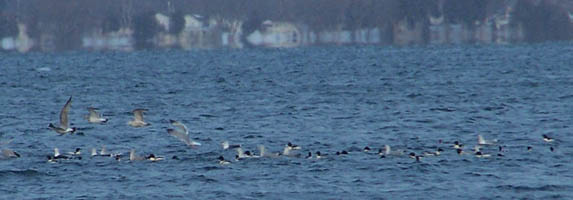
One of the pleasures of Orillia in November used to be the rafts of ducks in the open areas of Lake Couchiching between Couchiching Park and Ramara. Since 1999 the rafts have been disappointingly rare.
The gulls cruise the lake to find ducks so that they can steal their fish. The gulls seem to be disappointed too. Maybe this year is better. There were a few flocks, but on December 6/10 Donald Macdonald photographed this raft ( photo on the left) off Chiefs Island and Caroline Vardy photographed another raft, with the gulls harassing, off south Bay Street.
Both groups were all male Common mergansers. December 7th the lake was frozen; the ducks left during the night. Are there more ducks this year (Common Goldeneyes ), an indication that the fish are coming back to Lake Couchiching?
The Common Merganser has been found on all of the Orillia Christmas Bird Counts –often in large numbers, where there is still open water (the narrows or Lake Simcoe).
We have no record of the ratio of males to females (or to immatures).This year the observers made an estimate that there were a few females ( or immatures) among the Mergansers seen on Lake Simcoe – maybe 10-20%.
The Common Merganser is a cold-hardy, fish-eating duck that nests worldwide near large lakes and rivers in northern forested habitats. As a top predator in aquatic food chains, this species has served as an indicator
of environmental health both for contaminants and acidification.
They are often the last waterfowl migrant to move south in fall and first to return north in the spring; they may winter as far north as open water permits. Adult males return north first as soon as open water is available, followed by females a few weeks later.
In our photos it seems that the males are the last to leave.
Update:
- The flocks arrived on Lake Couchiching about December 6/11, increasing to good numbers.
- A flock was seen on McLean Lake December 2/11.
- Last raft to be recorded on Lake Couchiching December27, Lake froze Dec 28/11
Source material: Birds of N America online – Authors: Mallory, Merk and Metz
November 2010 – Rock Bass
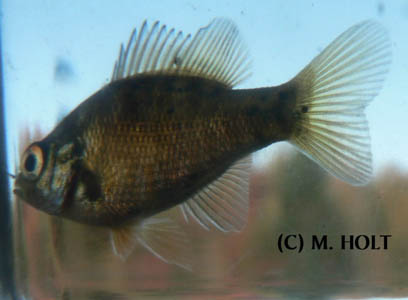
This Rock Bass was captured in a minnow trap while conducting a fish survey of a pond in the Copeland Forest, Oro-Medonte.\
Although Rock Bass is a native species, it has been widely introduced
into many lakes & streams in central Ontario where it was not native. Where introduced, it often causes a decline in native fish species due to predation & competition for food. In areas where Rock Bass are native, the fish community has adjusted over time to predation by & competition with Rock Bass.
Photo & text by Margo Holt
October 2010 SPIDERS
We asked people to send us photos they had taken of spiders- since they, and their webs, represent such a photo opportunity. The people who responded were all able to name their spiders.
Naming a spider may be a major challenge, however it doesn’t prevent us from simply enjoying their colour and diversity.
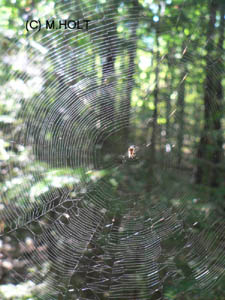
Spider awaiting dinner -Margo Holt
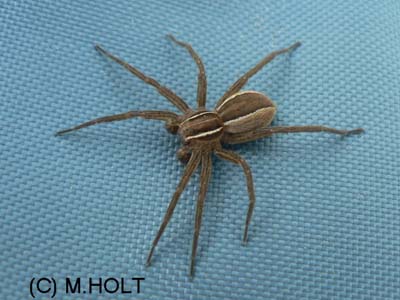
Six Spotted Fishing Spider – Margo Holt
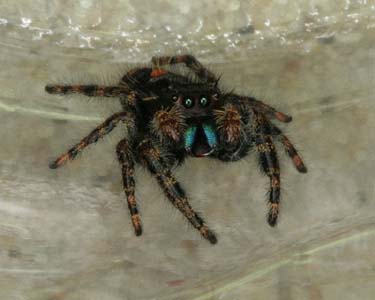
This is a spider photo taken in Muskoka September 6. It hitched a ride, we think, on some grapes we picked in Niagara.
Bold Jumper, Phidippus audax. Note the iridescent chelicerae (jaws)
– Al Sinclair.
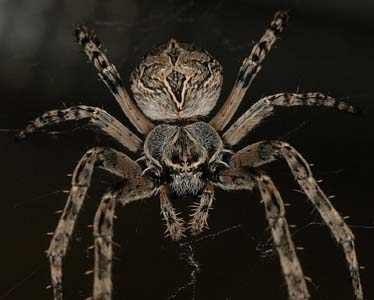
“Bridge spider – Larinioides sclopetarius is an extremely successful
colonizer of cities worldwide and inhabits buildings near water in
huge numbers. The spiders feed on insects that emerge from the water and are attracted to artificial lights, where the spiders build their webs.” –from a Google search, – Al Sinclair
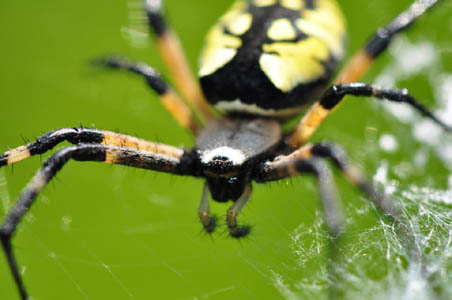
Black and yellow garden spider, taken at Rattray Marsh – Jon Clayton
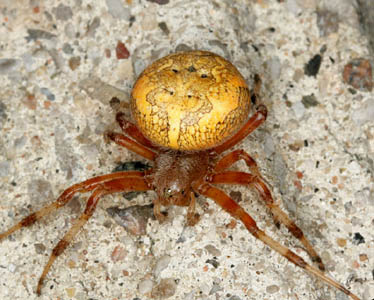
Araneus marmoreus – Marbled Orbweaver
photographed here in Muskoka today Oct 9, 2010
– Al Sinclair
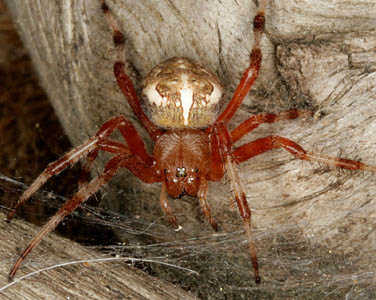
Another spider photo attached. Photographed in Muskoka
July 22, 2010.
Araneus trifolium – Shamrock Orbweaver (juvenile) -Al Sinclair
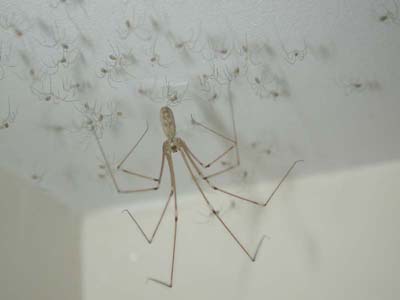
Long-bodied Cellar Spider. Pholcus phalangiodes.
This not only took up housekeeping in my
bathroom, but produced several hundred babies.
– Nancy Ironside
September 2010
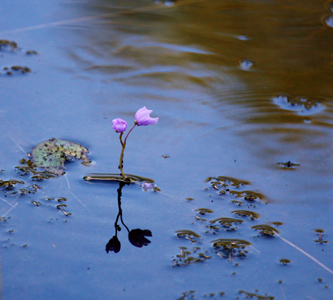
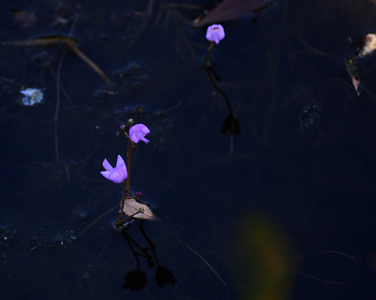
This photo of Purple Bladderwort (Utricularia purpurea) was taken at the Torrance Barrens in Muskoka.
Purple Bladderwort is a free-floating carnivorous aquatic plant.
The name Utricularia is from the Latin ‘utriculus’ meaning ‘a little bag’ in
reference to the tiny bladder sacs found in the whorls of submersed leaves.
The bladders have a trap door which opens to suck in tiny aquatic animals.
Until recently this carnivory was viewed as a typical predator-prey
interaction with the plants benefiting from nutrients derived from the
trapped organisms. Recent research has shown the bladders support living communities of microrganisms and that Bladderwort plants derive more benefit from the by-products of this living community than from carnivory. Thus it is the mutualism (mutual benefit) occurring in the bladders rather than the predator-prey interaction that is the most important association.
Text by Margo Holt
Photos by Rod Lee, of Brighton, taken at the Torrance Barrens
August 2010 FEMALE GIANT ICHNEUMON WASPS
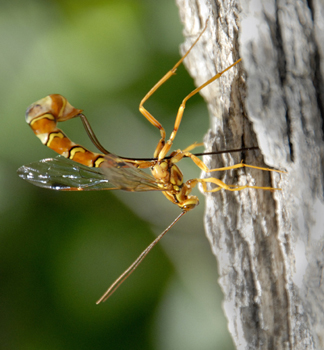



Mid June 2010, Ed Glanert discovered on his dying maple tree with boreholes, 2 of 4 species of North American Megarhyssa (Giant Ichneumon Wasps also called Stump Stabbers).
Looking at the photos: black and yellow Wasps are “atrata” species and the brown and yellow are “macrurus”.
This fascinating insect is approximately 3” in length with a 5” to 6” egg laying ovipositor extending from the end of the abdomen.
The ichneumon somehow discovers the location of Pigeon Horntail Wasp Larvae by pressing its long antennae against the bark of the tree. She then drills up to several cm. into the wood to reach the grub then delivers and attaches the nearly fluid egg to its target host.
The ovipositor is 3 filaments, 2 form a sheath to brace its abdomen. If needed as she drills, a disc (dime size) forms at the end of the abdomen and provides tension/pressure so the ovipositor can be driven deeper.
After the egg hatches it will wait until the host reaches a near mature size and then begin to consume it. The adult female will vary in size according to the size of its host.
Thank you Ed for sharing this learning experience with Joan, and now all of us, and thank you Joan ( Nixon ), for the remarkable photos and the concise and informative write up.
Addendum 2012:
Several of us were walking on the Concession near Ed Glanert’s home, and found this wasp in mid August 2012. We lifted it and put it on a tree ( it may have been injured). We have added these photos which demonstrates the amazing length of the ovipositor. This must be drilled into the wood to lay the eggs.
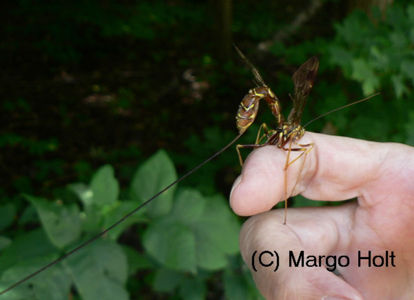
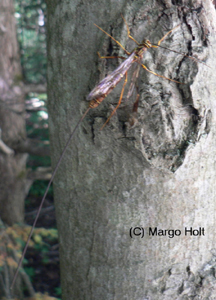
July 2010 DADDY WATER BUG
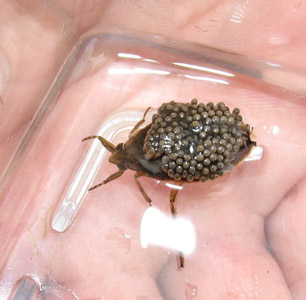 This Daddy water bug, which is likely Belostoma flumineum, was caught in a dip net by Bob Wright on the Aquatic Wildlife trip at the Carden Festival.
This Daddy water bug, which is likely Belostoma flumineum, was caught in a dip net by Bob Wright on the Aquatic Wildlife trip at the Carden Festival.
All the giant water bugs we caught at this time (June 4 and 5) were egg laden.
This photo was sent to us by Richard Aaron.
Steve Marshall’s book , Insects, their Natural History and Biodiversity, has a plate ( 133.3) showing the male Belastoma flumineum with eggs similar to this photo.
The eggs are deposited on its back, by females, following courtship and copulation. Encumbered males must swim at reduced speeds –which increases possible predation. The males remain near the water surface, ostensibly to expose the developing eggs to atmospheric oxygen and to prevent drying out, again increasing the possibility of predation. Can we learn something from the evolution of sex-role reversals in other
species, or is it too late? (or do we want to?)
June 2010 Map Turtle
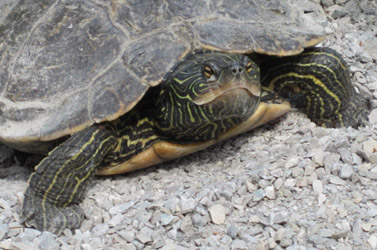
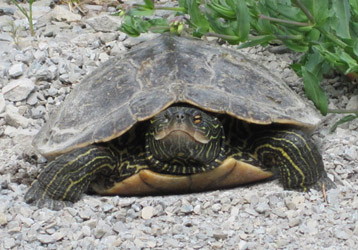
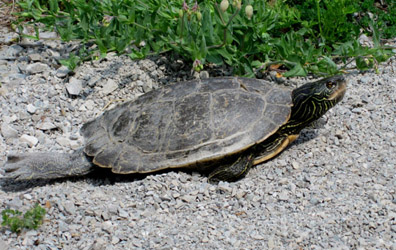 Ellen Dennig sent us these photos and this report: May 31 I was biking along the Tay Trail, as I sometimes do, and I saw this turtle sitting along the side in the gravel. I was about 1 km west of Pine Street in Waubaushene. When I looked closer I saw that it wasn’t a snapper, too small and scalloped carapace at the back. The colouring on the head and forearms reminded me of the map turtle, but the hind legs were so huge! It was still covering it’s eggs. I didn’t want to turn it over as I thought it might distress the animal. At home I confirmed that it was a Northern Map Turtle.
Ellen Dennig sent us these photos and this report: May 31 I was biking along the Tay Trail, as I sometimes do, and I saw this turtle sitting along the side in the gravel. I was about 1 km west of Pine Street in Waubaushene. When I looked closer I saw that it wasn’t a snapper, too small and scalloped carapace at the back. The colouring on the head and forearms reminded me of the map turtle, but the hind legs were so huge! It was still covering it’s eggs. I didn’t want to turn it over as I thought it might distress the animal. At home I confirmed that it was a Northern Map Turtle.
Note that the edge of the carapace at the rear is serrated. Ellen was very lucky ( in the right place), and observant to recognize this map turtle laying eggs. They are rarely seen in the wild since they are extremely wary.
It is a species of special concern Provincially and Nationally. In southern Ontario, it is found primarily on the shores of Georgian Bay, Lake St. Clair, Lake Erie and Lake Ontario, and along larger rivers including the Thames, Grand and Ottawa.
May 2010 Unusual Trilliums
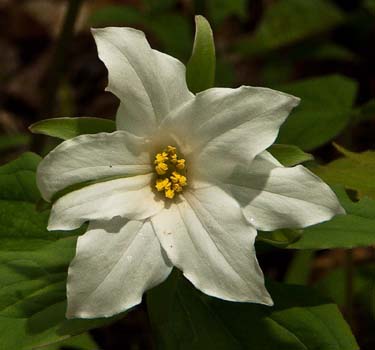
A double flower – 6 of everything
Yellow trillium -compare with red on right (often called a Wake Robin)
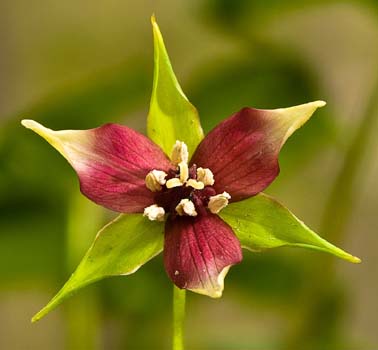
A variegated red and yellow Trillium – a colour form o0f the red.
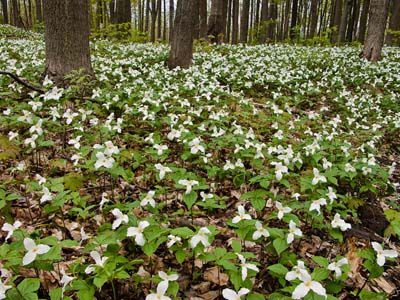
The Trillium is one of the plants whose seeds are dispersed by ants. The ants collect the seeds and feed a nutrient rich part to their larvae
in the nest. The undamaged seed is then available, and thus dispersed from the original plant.
Beautiful fields of Trilliums are found in the rich deciduous forests on the Oro Moraine – the double flower is on Mike Pidwerbecki’s property.
The commonest unusual trillium is a green and white. There are many photos of this on the net, including a photograph of a green and white trillium, which can be seen among the photos at the top of the Membership
and Contact page of this website. I can find no other photos of trilliums such as these, – found and photographed by Mike Pidwerbecki.
May 2010 BROWN CREEPER NEST
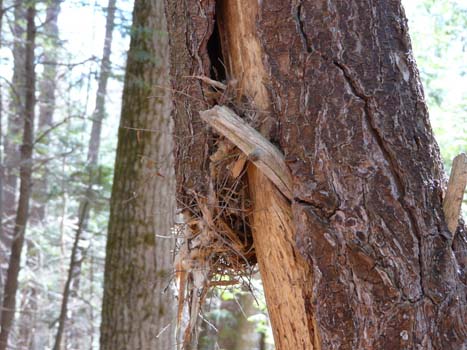
On April 13th, Dianna Wolfe of Kilworthy (south of Gravenhurst) reported that her resident Brown Creepers were acting agitated, in their back woods. Upon closer inspection, they found what appeared to be their nest: a jumble of old hemlock twigs, spider webs, and thin strips of dead wood jammed under a raised flap of bark on a rotting tree. She tells me that she has been checking the nest frequently but has not seen a bird actually fly into it. That said, there is often a creeper in the vicinity, so she is certain it’s still being used.
This is typical of the type of nest built by a Brown Creeper. Many of us have searched for the nest, with Brown Creepers in the vicinity, but have failed. The surreptitious behaviour of the adults makes the nests exceedingly
difficult to find. The Breeding Bird Atlas tells us that only 6% of all records are of occupied nests.
We thank Dianna Wolfe for letting us use her photo, and for her report.
April 2010 3 INVASIVE SPECIES: NEW AND WORRISOME AROUND ORILLIA

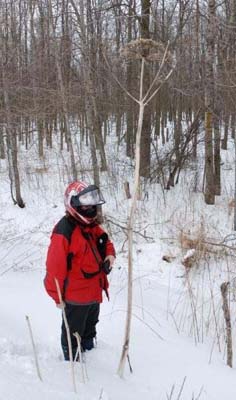
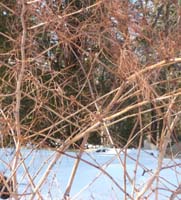
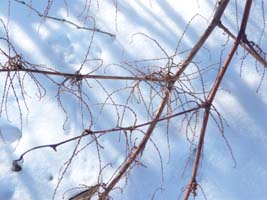
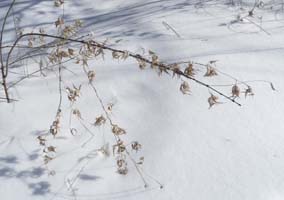

Dog-strangling vine (Vincetoxicum nigrum), a member of the milkweed family, is distinguished by its perennial vine habit, opposite leaves, purplish flowers, slender seedpods with parachute seeds, and somewhat milky juice. It can grow 1–2 m (3–6 feet)in height. Like other milkweed species, dog-strangling vine produces pods that split open lengthwise to disperse their seeds in the late summer. These pods are abundant in July and August and appear smooth and slender with a light green color.
The pods are shown here, in the winter, and are abundant along the Lightfoot Trail.
This tree killer, Japanese Knotweed (Fallopia japonicum) or Japanese Bamboo (Polygonum cuspidatum) forms dense thickets that exclude other vegetation. Clusters of creamy-white flowers appear in late summer in the upper leaf axils, the hollow stems have raised nodes, and stems can grow to 3 m tall (10 ft).
It reproduces mainly by vigorous creeping rhizomes that can form large dense patches. Japanese Bamboo is particularly difficult to kill because
of the rhizomes it sends down deep into the soil. Pulling or digging out can control it, but because of the depth of the rhizomes, results are not too satisfactory.
This problem plant has become common in Orillia, on the Lightfoot Trail, and on peoples’ front lawns and gardens. Giant Hogweed ( Heracleum mantegazzianum) is a member of the carrot family. It may grow up to 5 or 6 meters tall and the stem can grow to be 10 cm in diameter. The leaves might be 1 meter wide.
Except for its size ,it closely resembles cow parsnip. The “flower” is a compound umbel, up to 120 cm across. It exudes a clear watery sap, which may cause a severe and persisting dermatitis. This tenacious perennial, which is difficult to eradicate, was introduced to North America as a garden plant from southwestern Asia.
Brendon Ackert took these photos of the Giant Hogweed, last month, on the Uhthoff Trail.
FOR MARCH 2010 PRAIRIE HORNED LARK
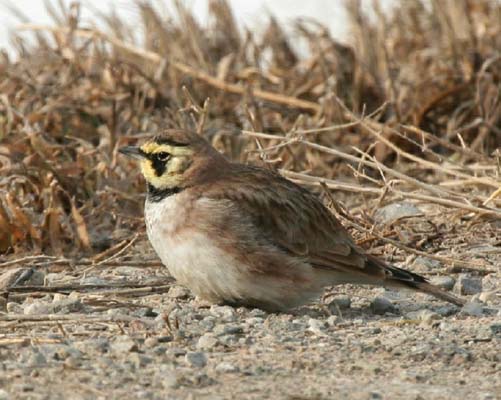
A Harbinger of Spring: The Horned Lark
The Horned Lark is the first migrant to return to Simcoe County. I saw my first Horned Lark of 2010 on Feb. 4 in Clearview ( formerly Sunnidale) Township.
We have three subspecies of Horned Lark occurring in Simcoe County. The Prairie Horned Lark (Eremophila alpestris praticola), as shown in the photograph, is the first to return and stays to breed. It has a white eyebrow stripe.
The other two subspecies are transients in Simcoe and do not stay to breed.
The Northern Horned Lark (E. a. alpestris) has a bright yellow eyebrow stripe.
Hoyt’s Horned Lark (E. a. hoyti) is larger, has a white eyebrow stripe, and is an uncommon migrant in Simcoe.
Thanks to John Warnica for the photo and to Margo Holt for the text.
February 2010 HEAD RIVER KEYHOLE
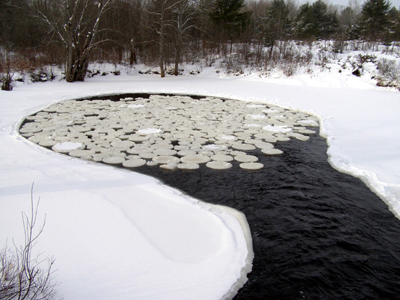
This was seen on the Carden Bird Count – the Head River drops through a little rapids into a pool with a right-angle turn – the open water goes in a constant circular motion, creating these round chunks of ice in a keyhole – very neat.
Photo and observation from Ron Reid.
January 2010 THE OUTLIERS
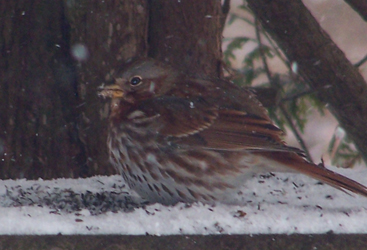 This Fox Sparrow spent 5 days, December 11-15, at 258 Bay St , in Orillia.
This Fox Sparrow spent 5 days, December 11-15, at 258 Bay St , in Orillia.
It came when Muskoka had a major snowstorm, and left when Orillia had a storm. On the web this year, birders have reported Fox Sparrows in Huntsville Oct 26, in Hamilton Dec 4, and in Stratford Dec 13. Photo by Carrie Vardy
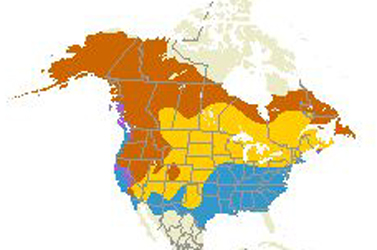 Orange represents summer breeding grounds Yellow represents migrating routes Blue represents wintering grounds. Map adapted from Cornell Lab of Ornithology.
Orange represents summer breeding grounds Yellow represents migrating routes Blue represents wintering grounds. Map adapted from Cornell Lab of Ornithology.
Genetics will probably split the Fox Sparrows into 4 species; those that migrate through Simcoe County (the east) are the Red Fox Sparrow (Passerella iliaca iliaca). Most birds move through the county rather quickly during April, on their northward flight. The greatest number of southbound migrants travel from about October 15th to 30th. Why are there these outliers? ( In statistics an outlier differs markedly from the rest of the data.)
Many people consider that northern migrants who reach breeding grounds early, may get the best nesting sites, but, alternatively, they may starve or freeze to death. There are several possible ideas about the benefits of leaving their breeding grounds late in the fall. Malcolm Gladwell in his current best selling book “The Outliers”, postulates why some people, who are outliers, do well ( some don’t).
Maybe my little bird, who ate and ate while it was here, may be destined for great things; or it may die during the migration.
